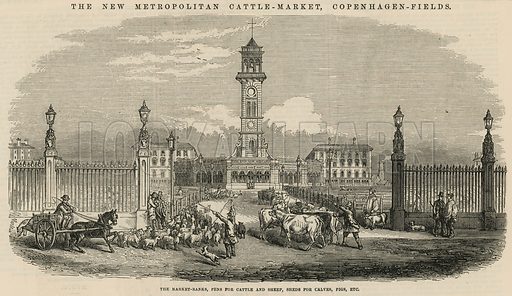
For the first part of this story follow this link
Ernest Cogdon saw John Broome Tower several times on 31 December 1884. The two men were friends and Cogden said they met at Haycroft and Gilfillon’s offices in Great Winchester Street where Broome Tower worked as an underwriter’s clerk.
The course of his work meant that Cogden, a fellow clerk, ran into Tower three more times that day before the pair took a train back to Finsbury Park (where Cogden lodged) at 6.30 that evening. They dined with a Mrs Earl and her daughters (one of whom was sweet on John) before going to a service at St John’s Church in Highbury Vale. It was well past midnight when they parted company on Green Lanes, Cogden going back to Finsbury park and Tower to his digs at 109 Dynevor Road in Stoke Newington.
That was the last time anyone saw John Broome Tower alive but Cogdon was sure he left his chum in good health, sober and with money in his pockets. They’d agreed to meet the following day for lunch. Cogdon was also puzzled that Tower’s body had been found where it was, as he was not on his normal route home; what had caused him to change his habits that night and did he take his own life, or was he murdered?
The police were pursuing the second option: when Tower’s body had been recovered it seemed as if he’d been attacked. His hat was battered (and it wasn’t an old hat), he collar looked as if it had been wrenched from his neck, and the state of his coat suggested the wearer had been involved in a struggle. More than one set of footprints were discovered near the bank of the reservoir where the body was found, and only one matched the boots Tower was wearing. A scarf or large handkerchief was around his neck, spotted with blood, and the press and police speculated that he had been strangled with it. However, there were no other wounds that might have accounted for his death.
It was a proper Victorian ‘murder mystery’ in ‘the rapidly growing northern suburb’ as the Penny Illustrated Paper described Stoke Newington. It provided its readers with a sketch of the locality and an artist’s impression of the finding of the body at the reservoir (above). No one had heard a sound that night despite there being several potential witnesses including a cab driver, two carriages, and two young lads being close to the scene of the supposed attack at the time.
The police had employed divers to search the reservoir, men working for Doewra and Co., but they had not uncovered anything that might help explain the circumstances of the death. The police, under the direction of N Division’s Superintendent Green, remained baffled and were offering a reward of £100 for information.
Several days later the police investigation had still not resulted in an arrest. Enquiries at Tower’s workplace had now revealed that ‘discrepancies’ in his accounting which hinted at workplace theft. The amounts were significant but not huge – £60-80 – and no cheques were missing. Had Tower killed himself to avoid disgrace? It seemed unlikely, especially as Dr Bond (who examined his body) found no sign that he’d drowned in the reservoir. This suggested to him that he’d been killed first and then thrown into the water. Bond (who was later to be involved in the Whitechapel Murder case of 1888-9) was ‘clearly of opinion that death resulted from homicidal strangulation, and that two or more persons had been engaged in the matter’.
Two years later the case remained unsolved. A man did confess to killing Tower and robbing him with an accomplice but his evidence contradicted much of what the police already new and little credibility was given to it. In 1886 the papers reported that Chief Inspector Donald Swanson was convinced that the poor man had committed suicide. Another theory was that he had been decoyed into the area of scrub near the reservoir by a woman, and then attacked and killed. Swanson may have been content to put the mystery to bed as suicide because it relieved the police of responsibility for finding the killer/s, however unlikely it seems from the evidence presented to the coroner.
The mystery certainly caught the attention of people at the time and the 1886 confession (by a man named Thackery) was not the only one. In January 1887 George Charles Wilson also said he’d killed the underwriter’s clerk but he was dismissed as being unfit to do so suffering as he was, from ‘a disturbed mind’ and being found wandering as ‘a lunatic’.
In the end the crime was and remains unsolved. Somebody killed John Broome Tower or else he made it look that way. It had briefly propelled the outlying suburb of Stoke Newington to national attention, something I’m not sure its inhabitants would have welcomed.
[The Penny Illustrated Paper, 12 January, 1884]
















 The captain had purchased it in Siberia and when the policeman had stopped him he was on his way to Sandringham to deliver it to his highness. So what sort of dog was it?
The captain had purchased it in Siberia and when the policeman had stopped him he was on his way to Sandringham to deliver it to his highness. So what sort of dog was it?  Quite possibly a Siberian Mastiff (see image), these were large dogs indeed and probably quite an outlandish sight on the streets of the capital in 1889. It could have been a Husky of course, more popular today and perhaps more familiar, but not particularly large.
Quite possibly a Siberian Mastiff (see image), these were large dogs indeed and probably quite an outlandish sight on the streets of the capital in 1889. It could have been a Husky of course, more popular today and perhaps more familiar, but not particularly large.
